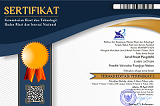Pengurbanan Kerbau pada Upacara Rambu Solo Masyarakat Toraja: Identifikasi Karakteristik untuk Mendukung Pelestarian Budaya
Abstract
The buffalo-fighting rituals in Rambu Solo's funeral ceremony in Tana Toraja and North Toraja illustrates continuity and change in that community and the state of and alteration in economic stratification in Toraja. The number and type of buffaloes sacrificed at a funeral indicate the social class of the participants. Before the buffaloes are slaughtered, they are pitted against each other in a ritual fight to console the grieving family. This study was performed using ethnographic methods. It relied on participant observation and in-depth interviews. There are social gaps in funeral rituals in Toraja. However, the class itself is shifting. Previously, expensive events involving the sacrifices of many buffaloes were privileged to noble families. However, the ability to hold such ceremonies is open to anyone possessing wealth. Wealthy families who are not from noble lines can also hold such ceremonies. Contemporary ceremonies now feature gambling on buffalo fights. The fact that a buffalo-fighting arena is present at a funeral ceremony indicates the presence of gambling. Furthermore, such arenas can be expected to accompany the planned sacrifice of a large number of buffaloes. The increased presence of buffalo-fighting arenas and gambling at funeral ceremonies constitutes a new signifier for funeral ceremonies in Toraja.
Keywords
Full Text:
PDF (Bahasa Indonesia)References
Corrigan, P. (1997). The Sociology of Consumption. Sage
de Jong, Edwin. (2013). Making a Living between Crises and Ceremonies in Tana Toraja: The Practice of Everyday Life of a South Sulawesi Highland Community in Indonesia. Brill.
Ewen, Robert B. (2003). An Introduction to Theories of Personality. Lawrence Erlbaum Associates.
Feist, Jess & Gregory J. Feist . (2010). Teori kepribadian (Theories of personality). Salemba Humanika.
Haq, Ika Nidaul. (2022). “Budaya Pamer dan Krisis Identitas”, Nusantarapedia.net
Ibrahim, Idi, Subandy. (1997). “Pesona Hedonisme dan Pemujaan Konsumsi” dalam Ibrahim & Malik (Eds), Hegemoni Budaya. Yayasan Bentang Budaya.
Jeffries, Vincent and H. Edward Ransford. (1980). Social Stratification: A Multiple Hierarchy Approach. Boston: Allyn and Bacon
Mahyuddin. (2017). “Social Climber Dan Budaya Pamer: Paradoks Gaya Hidup Masyarakat Kontemporer”, Jurnal Kajian Islam Interdisipliner, 2 (2), 117-135. https://doi.org/10.14421/jkii.v2i2.1086
Malinowski, Bronislaw. (2002). Argonauts of The Western Pasific, An account of native enterprise and adventure in the Archipelagoes of Melanesian New Guinea, Routledge London.
Manta’ R., Yohanes. (2011). Sastra Toraja, Kumpulan Kada-Kada To Mina dalam Rambu Tuka’ dan Rambu Solo’, PT Sulo, Rantepao.
Marcel Hénaff, Mauss. (2010).: “The Father of Reciprocity”, in Revue du MAUSS Volume 36, Issue 2, 2010, pages 71 to 86
Marcus, George E. (1995). “Ethnography in/of the World System: The Emergence of Multi- Sited Ethnography”, in Annual Review Anthropology, 24, 95-117. https://doi.org/10.1146/annurev.an.24.100195.000523
Mauss, Marcel. (1967). The Gift. New York: Norton & Company
Max Weber (1930). The Protestant Ethic and the Spirit of Capitalism. London & Boston: Unwin Hyman,.
Dewi, Ni Made Adinda Wikan & Made Subawa (2018), “Penerapan Asas Manfaat Dan Asas Timbal Balik Dalam Perpres R.I No. 21 Tahun 2016 Tentang Bebas Visa Kunjungan”, dalam Kertha Negara, Vo. 06, No. 04, Agustus 2018
Nanang, Martono (2011), Sosiologi Perubahan Sosial Perspektif Klasik, Modern, Posmodern dan Poskolonial, Jakarta: Rajawali Pers.
Nooy-Palm, Hetty. (1979), The Sa'dan Toraja: A Study of Their Social Life and Religion,Vol. I, Organization, Symbols and Beliefs, KITLV, Leiden
Piliang, Yasrat, Amir, 2011,Dunia Yang Dilipat Tamasya Melampaui Batas-Batas Kebudayaan,Bandung: Jalasutra.
Polak, J.B.A.F. Mayor (1979). Sosiologi suatu buku pengantar ringkas. Ichtiar Baru :Jakarta
Ralph Linton, The Study of Man (New York: Appleton-Century-Crofts, Inc., 1936), pp. 115-31.
Sarup, Madan.2003. Panduan Pengantar untuk Memahami Post- struktural & Posmodernisme,Yogyakarta: Jendela.
Scarduelli, Pietro. (2005). “Dynamics of Cultural Change among the Toraja of Sulawesi: The Commoditization of Tradition”, in Anthropos, Bd. 100, H. 2., pp. 389-400
Soekanto, S. (2010), Sosiologi Suatu Pengantar, Jakarta, Rajawali Press.
Veblen,Thorstein (2007), The Theory Of The Leisure Class, Oxfor University Press.
Volkman, Toby Alice. (1980). The Pig Has Eaten The Vegetables: Ritual And Change In Tana Toraja, Cornell University, ProQuest Dissertations Publishing, 1980.
Volkman, Toby Alice (1990): "Visions and Revisions: Toraja Culture and the Tourist Gaze," in American Ethnologist 17, pp. 91-110
Waterson, Roxana. (2009). Path and Rivers:Sa’dan Toraja Sociaety in Trasnformation. KITLV Pres, Leiden.
DOI: https://doi.org/10.21107/pangabdhi.v9i2.22835
Refbacks
- There are currently no refbacks.
Copyright (c) 2023 Augustine Sem Porak Tangkeliku, Sulistyowati Irianto

This work is licensed under a Creative Commons Attribution-ShareAlike 4.0 International License.
Jurnal Ilmiah Pangabdhi by Universitas Trunojoyo Madura is licensed under a Creative Commons Attribution-ShareAlike 4.0 International License.













